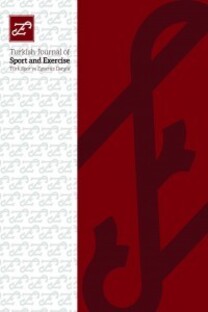Evaluation of physical fitness parameters of hearing impaired adolescents who are active and non-active in sports
Hearing impaired; adolescent; sport; physical fitness
-
Hearing impaired, adolescent, sport physical fitness,
___
- Bosco P, Luthanen P, Komin V. A simple method for measurement of mechanical power in jumping. European Journal of Applied Physiology, 1983; 50: 273- 282.
- Cavkaytar A, Diken İH. Özel Eğitime Giriş. Kök Yayıncılık, Ankara, 2005.
- Ciğerci AE, Aksen P, Cicioğlu İ, Günay M. 9-15 yaş grubu işitme engelli ve işitme engelli olmayan öğrencilerin bazı fizyolojik ve motorik özelliklerinin değerlendirilmesi. Selçuk Üniversitesi Beden Eğitimi ve Spor Bilim Dergisi, 2011; 13 (ek sayı): 35-42.
- Craft DH. Visually impairments and hearing losses. Adapted Physical Education and Sport (Ed: J. P. Winnick). Champaigne, 1995; 143-166. Human Kinetics Books
- Çalışkan E, Pehlivan A, İnal S, Dane Ş, Akar S. Goalball Sporunun ve Hareket Eğitiminin Görme Engelli Çocukların Fiziksel Uygunluk Üzerine Etkilerinin Değerlendirilmesi. Beden Eğitimi ve Spor Bilimleri Dergisi, 2006; 8(3).
- Ergun N. İşitme engellilerde fiziksel eğitim. BEGV dergisi, 1995; 1(2): 26.
- Fernhall B. Physical fitness and exercise training of individuals with mental retardation. Medicine Science Sports and Exercise, 1993; 25(4): 442–450. 8. Gür A. Özürlülerin Sportif Etkinliklerin T.C. Süreçlerinde Başbakanlık Özürlüler İdaresi Başkanlığı, Ankara, 2001. Rolü.
- Hartman E, Houwen S, Visscher C. Motor skill performance and sports participation in deaf elementary school children. Adapted Physical Activity Quarterly. Human Kinetics, Inc, 2011; 28: 132-145.
- Özer DS. Engelliler İçin Beden Eğitimi ve Spor, Ankara: Nobel Yayın Dağıtım, 2001.
- Özer, DS. Engelliler için Beden Eğitimi ve Spor. Ankara: Nobel Yayın Dağıtım, 2004.
- Rajendran V, Roy FG, Jeevanantham D. A preliminary randomized controlled study on the effectiveness of vestibular specific neuromuscular training in children with hearing impairment. Clinical Rehabilitation, 2013; 27(5): 459–467.
- Rantanen T. MidIife handgrip strength as a predictor of old age disability. Journal of the American Medical Association, 1999; 281(6): 558-560.
- Rimmer JH, Braddock D. Health promotion for people with physical, cognitive, and sensory disabilities: an emerging national priority. Am. J. Health Promot, 2002; 16: 220–224.
- Sevim Y. Antrenman Bilgisi, Ankara: Tutibay Ltd.Şti., 1997.
- Strong W, Malina RM, Blimkie CJR, Daniels SR, Dishman RK, Gutin B. Evidence based physical activity for school-age youth. J Pediatr, 2005; 146: 732– 737.
- Surakka A, Kivelä T. The effect training of a physical training programme on flexibility of upper body and trunk in visually impaired and deaf-blind persons. EuropeanJournal of Adapted Physical Activity, 2011; 4(1): 7-21.
- Şirinkan A. 10-15 yaş işitme engelli öğrencilerde sportif eğitsel oyunlarin fiziksel gelişimlerine etkisinin araştirilmasi. Selçuk Üniversitesi Beden Eğitimi ve Spor Bilim Dergisi, 2011; 13(Ek Sayı): 74- 80.
- Tamer K. Sporda Fiziksel Fizyolojik Performansın Ölçülmesi ve Değerlendirilmesi. Bağırgan Yayınevi, Ankara, 2000.
- Tsimaras VK, Kyriazis DA, Christoulas KI, Fotiadou EG, Kokaridas DG, Angelopoulou NA. The effect of a traditional dance training program on the physical fitness of adults with hearing loss. Journal of Strength and Conditioning Research. 2010; 24(4): 1052-1058.
- Tüfefçioğlu Ü. İşitme, konuşma ve görme sorunu olan çocukların eğitimi. Anadolu Üniversitesi Yayınları, Ağustos, 2006.
- Yılmaz A, Kaya M, Kul H, Kurt AK. Düzenli egzersizin işitme engelli ve normal bireylerde statik denge üzerine etkisi. Uluslararası Akdeniz Spor Bilimleri Kongresi, Antalya, 2007.
- Zorba E. Fiziksel Uygunluk. Ankara: Neyir Matbaası, 2000.
- Yayın Aralığı: 3
- Başlangıç: 1999
- Yayıncı: Selçuk Üniversitesi, Spor Bilimleri Fakültesi
Examining university students' attitudes towards fat phobia
Hüseyin OZTURK, Yakup Akif AFYON, Recep SARIKAYA, Emre TUREGUN
Physical education candidate teachers' beliefs about vocational self-esteem
Futbolcularda Yeterlik İnancı, CSAI-2C, SCAT ve Başarı Algısının Karşılaştırılması
Ozge CAGLAR, A. ULUDAG, Tulin SEPETCI, Erkan CALISKAN
Physical education candidate teachers' beliefs about vocational self-esteem
Murat OZSAKER, A. Meliha CANPOLAT
Ezgi ERTUZUN, Bülent FISEKCIOGLU
The effects of detraining period on female basketball team players aged 10-12 *
The determination of knowledge levels related to doping in elite athletes
